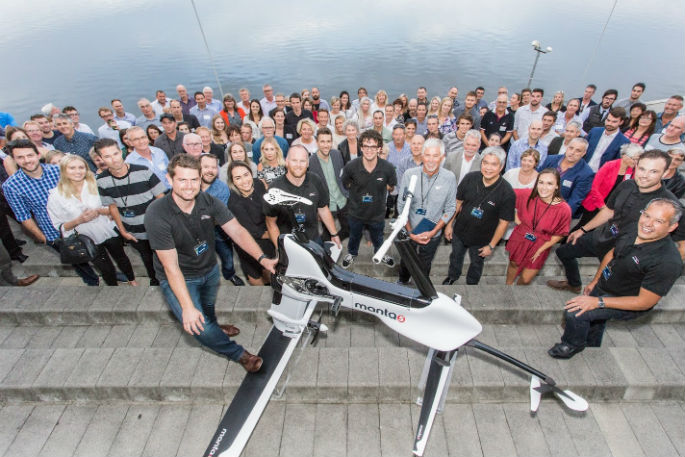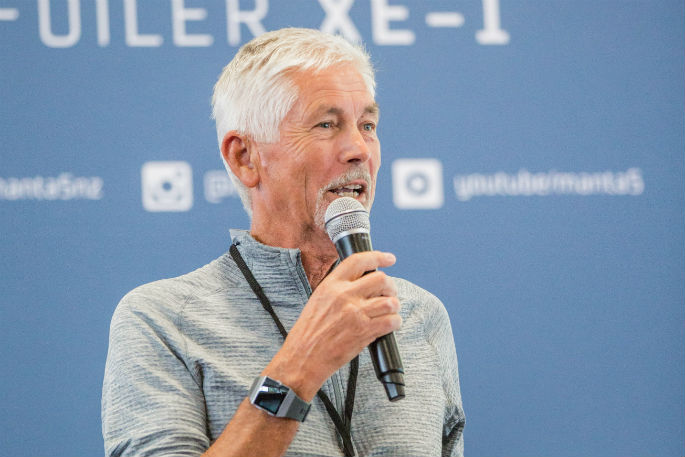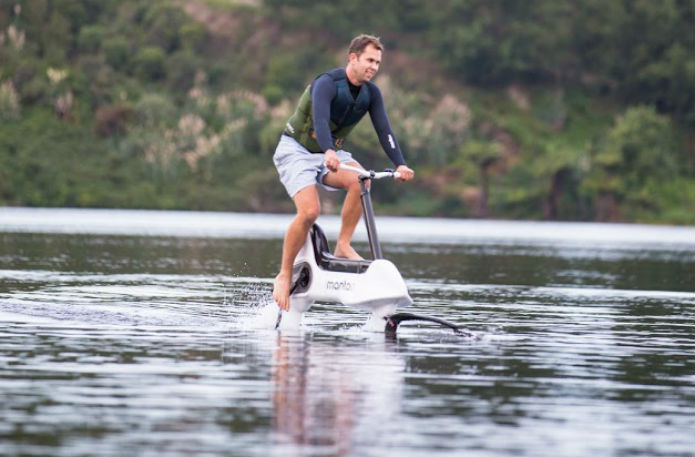The recent market launch of the Manta5 hydrofoil bike marks the completion of a six-year development path with a strong Mount Maunganui component.
The first two years of the construction and design of the foiling water bike were secret, with trials of prototypes taking place in a pool at Windermere.
The idea is Guy Howard-Willis' but he was held up for some time looking for a designer/builder.
'I've had the idea floating around in my head for quite a few years,” says Guy.
A conference speaker prompted him to do something about it.
'The speaker said two things. ‘Quite often you will have an idea and you will sit on if for a while then someone else will do it'.
'The other thing he said was - ‘the idea that you had; when you get to the end of your life and think to yourself, I wonder if that would have worked'.
'This just really prompted me.
'I went on the hunt to find a designer. You know it's not easy.”
His designer turned up one day at the shop. At the time Guy and his wife owned Topedo7.
'This chap came in and he showed me his bike that he had made. It was a downhill bike and it had smaller wheels on it. I was really intrigued
'Where do you get these parts from? ‘Oh I made these'. 'What about these? ‘Oh I designed and made those as well'.
'Roland Alonzo, a very, very, clever bloke. Not only can he design stuff, he can actually make it as well, and it's hard to find people like that.”
Roland had a job at the time and agreed to work on Guy's bike over weekends, but he was still a bit reluctant. He couldn't swim.
Guy persuaded him. 'Designers of formula one cars don't get to race them.”

Some of the crowd at the recent launch. Photo: Supplied.
The first tests were so secret only their wives knew about it for two years says Guy.
'We had to prove certain things,” says Guy.
They had to prove the assumption that the bike would foil, that the foils would support a rider and the weight of the bike. Next there was propulsion and they had to go through a whole lot of exercises to see if a rider could propel themselves.
Their test rider was a friend of Roland's Clendon Greenway.
'He was the first test pilot. He was from Tauranga too, and he was so important to us,” says Guy.
'Imagine in those early days when we were testing the foil and the props, that he couldn't get it to go. You would think ‘Oh this is not going to be possible'. But the fact that he did kind of pushed us along. If he could do it anyone could do it, but he is a surfer and a bit of an athletic sort of bloke.
'But if we had a person who said ‘Nah this is not going to foil…'”
The way they first found out if it was going to foil was to literally drag it along the pool at the Toi Ohomai Institute of Technology's pool at its Windermere campus, with a rope.
'We proved that assumption that you could actually do this on the second prototype. This is in the open air pool at Windermere. We hired the pool over there. He could propel himself and he could foil – not far, but enough. And we made the third prototype.”
This was carbon fibre intended to be 10kg but it came in at 15kg.
'That prototype 3 worked so well. The other thing it had to prove was the water start. If you were in a lake and you stopped pedalling or you went down what would you do? So that took us years to perfect.”
We call it the submerged launch. You get back on the bike, you sit it upright then you do about 15 hard pedal strokes then you climb out onto the water and you are off again.”
Another prototype has the electric motor and battery. It made the bike a bit heavier but it opened the market up to far more people.
'You just have to keep pedalling,” says Guy. 'It's not like cycling on the road where every now and then you can drift long and not pedal. You have to keep pedalling, you just have to keep pedalling.”
It changed everything. The bike doesn't go faster but it goes for longer, says Guy. One of their riders went of an 80 minute ride on Lake Karapiro and stopped not because he ran out of battery, but because the saddle was too hard.
The protoype 6 which was demonstrated at the recent launch is the one to be manufactured.
'We are just getting the final steps of doing all our drawing so we can send them off to manufacturers to make the moulds,” says Guy.
They are planning on keeping manufacture of the important bits; the foils the propeller and gearbox in the country at this point.
There is a waiting list of 16,500 people wanting Manta5s
'That's from all over the world,” says Guy. 'We can't produce that many that quickly, so it's going to be over a year or two. It's kind of a good problem to have.”
The Facebook video of the manta5 on Lake Karapiro went viral and that changed everything. More than two million people saw that video.
The Red Bull interviewer on Skype told him why.
'Surely you understand that you have created a new sport. There's nothing out there like that, that does what you do.”
The Manta5 will comfortably travel at 22km/h on water.
'That's faster than a rowing eight, because we have been past them when they have been training on Lake Karapiro, and they don't like it. Someone rides a bike past them,” says Guy.
Future developments include an all manual carbon fibre sport model, probably one for surf…
'We are going to do down the track of all these things.”

Guy Howard-Willis. Photo: Supplied.



0 comments
Leave a Comment
You must be logged in to make a comment.